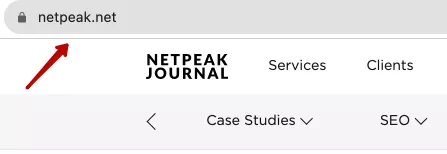How to Avoid Losing Traffic During Website Migration
Both business owners and marketers often face the need to migrate their websites. This long and complicated process can be intimidating in its scope. However, having a detailed plan and working with SEO specialists makes it much easier.
Different types of website migration
Website migration is the process of making changes to a website's location, technology, structure, content, design, or user interface. There are several types of website migration. Some of them are easier to implement, and others are quite complex, but all of them require the involvement of an SEO specialist.
Simple migrations
The main reasons for simple migrations are switching from HTTP to HTTPS and changing the domain name of a website. They do not involve significant changes in the site's appearance, structure, and functionality. Therefore, they tend to be quicker and easier to do.
These types of migrations are considered “simple” because they involve making the same type of changes using code. In one case, all URLs are changed from HTTP to HTTPS; in the other, all pages are renamed when the domain is changed. This makes it much harder to make a mistake when setting up page gluing.
Despite their apparent simplicity, these migrations are still as risky as more complex cases. Therefore, it is crucial to involve an SEO specialist who will check the URLs for correctness using their own methods. They will make sure that everything has been moved correctly and that there are no programmatic errors.
Migration from HTTP to HTTPS
This type of migration is quite rare nowadays, as HTTPS encryption has been one of Google's ranking factors since 2014. Since July 2018, popular browsers, including Chrome, Mozilla, and Safari, have marked all HTTP sites as insecure.
Newly created sites are launched with HTTPS by default, but this migration may be necessary for old sites that have not been used for a long time.
Change of domain name
There are a number of reasons for changing a website's domain name.
- The company has changed its name. This usually happens after rebranding.
- The domain name is difficult to remember. Maybe it has too many hyphens and numbers or is long and complicated. The site's domain name should pass the "radio test." If someone hears the domain name on the radio, they should be able to understand how it is spelled and get to the site without seeing the name in print.
- The domain extension needs to be changed. Maybe there was insufficient budget for a .com domain name initially, but now there is. Or vice versa, the company bought a .org domain, but it turns out that it would be better to use .tech or .net in this niche.
Simple types of migrations require setting up 301 redirects and "gluing" old and new pages together, which means you need a specialist's skills and constant monitoring of the migration process.
Complex migrations
Complex migrations require more effort as they involve changes in the site's appearance, structure, and functionality.
In complex migrations, page URLs change in completely unpredictable ways. The directory structure may change, page titles may be generated differently, etc.
The difficulty is that you must compare old and new pages to set up redirects. If you have a large site with thousands of pages, you will need a programmer to write a special script for automatic or semi-automatic comparison. Sometimes, old pages are named manually without any specific structure. These pages can be very difficult to separate and match using code, so you have to do it manually.
Website redesign
A website redesign involves significantly modernizing the site to improve the user experience. On average, companies tend to redesign their websites every three years. It allows you to update the look, improve the navigation, and add new features and capabilities to the site.
Moving to a new website
When a website needs significant design, structure, and functionality changes, it is sometimes cheaper to create an entirely new website than to fix the old one.
Case study: The team behind the online jewelry store Ukrzoloto decided to move their content to a new website. They turned to Netpeak for recommendations on how to make the move.
Our goal was to ensure that Ukrzoloto's website migration went smoothly without any significant loss in traffic and sales. What did our experts do?
- First, we provided advice on how to preserve the URL and catalog structure.
- We then explained how to transfer Google Analytics to the new site.
- We also provided recommendations on setting up SSR (Server-Side Rendering).
- Finally, we helped set up the new site's Google Analytics goals and e-commerce.
Our specialists also managed the online store after the move and were able to track how the migration impacted website promotions and traffic.
Results: Over the next year, traffic increased by 103.58%.
Migrating from a site builder to a CMS
Website builders often have weak functionality, a small selection of designs, and limited management options.
Case study: The Atlas fabric store had been operating offline for a long time. The first online store was launched using the Prom.ua website builder. As the company grew, it became clear that the website needed additional functionality and wanted to promote itself regardless of the platform.
Therefore, the Atlas team turned to Netpeak to move from the builder to a new CMS. Our team helped them perform a competent migration, keep the old site's traffic, and prepare the foundation for further SEO promotion.
What did our specialists do?
- Helped with the move.
- Developed an extended site structure.
- Optimized the system of filter pages.
- Adapted language versions of the site.
Results: There was a notable increase in the total amount of traffic after the move.
Moving to a new CMS
As a business grows, the old website may no longer meet its needs. For example:
- The site can't handle large volumes or sudden spikes of traffic.
- The company loses customers because it is challenging for users to find and purchase goods.
- It is difficult to connect the necessary advertising tools and systems to the site on the old CMS.
- You want to use modern marketing tools to increase sales, but the site has limited functionality.
Case study: The large pet store and grooming salon chain MasterZoo did not have a full-fledged online store. Their website didn't even have a "Buy" button or a checkout process and only had an option for users to "Suggest Improvements."
MasterZoo created a new online store on the Horoshop engine, and they turned to the Netpeak team to help them make the move without losing traffic from organic results.
What did our specialists do?
- We set up 301 redirects from the old URLs to the new ones to "glue" the catalog pages to the online store pages. This way, search crawlers saw that they were the same pages, but the addresses had changed (not the domain itself, but partially the URL). As a result, the value of the old addresses was transferred to the new ones.
- We set up 301 redirects from the deleted pages of the site. These pages were ranked for a number of search queries, and external resources were linked to them.
- We saved the tags, meta tags, and content from the old pages.
- We transferred and set up web analytics systems, including Google Analytics, Google Tag Manager, and Google Search Console.
All this was done very quickly: we started work on March 27, and the site moved to the new CMS on April 1.
As a result, the site did not lose any traffic after the move.
Risks of redesign and migration to a new CMS
A complex migration directly impacts SEO because Google has to re-index the entire site after the migration. Therefore, in the short term, the amount of organic traffic is likely to decrease. However, in the long run, migration can improve page rankings, as Google prefers fast and user-friendly websites.
To prevent major losses in traffic, you need to involve SEO specialists when planning a migration. They need to perform three main tasks:
- Transfer all of the site's content.
- Preserve the link mass.
- Match old and new URLs.
The success of the migration depends directly on the expertise of the team involved. Inexperienced specialists may fail to set up important 301 redirects or lose important pages, link mass, and traffic. They may also fail to transfer text and meta tags to new addresses.
If the migration is not done properly, you may have the following problems:
- Decrease in website rankings in organic search.
- Decrease in site authority.
- Difficulties with analytics tracking, mobile adaptability, and page speed.
But if you set up the necessary redirects and transfer content and meta tags correctly, you should have no problems.
How to make a complex migration work
There are four key components to a successful migration.
- Step-by-step planning. A detailed plan will keep the process organized and avoid a negative impact on SEO.
- Thorough preparation for migration. It is necessary to select and prepare data in the correct format for transfer in advance.
- Clearly written and implemented Statement of Work. A Statement of Work is an important document that outlines a project's scope, schedule, and cost between two parties, usually the customer and the vendor. Its purpose is to ensure that all parties have a common understanding of the expectations and responsibilities associated with the project.
- Well-coordinated teamwork. Website migration involves a large number of specialists from different teams. They need to communicate with each other and try to achieve the goal in the most efficient way.
The main stages of website migration
Website migration is organized into three main stages.
Stage 1: Preparing for the migration
This is the most time-consuming part of the process. It is important to create a detailed plan and prepare the content for migration. This phase can be divided into several parts.
- Plan and define the scope of work. At this stage, you need to create a work plan, establish deadlines, form teams, and provide team members with all the data they need to work.
- Save information from the old site. You need to save the main traffic sources from the old site so that they can be transferred to the new site without loss.
- Advertising during development. You need to create new tools to attract traffic and minimize losses during migration.
- Final testing, comparison of sites, and preparation for release. Test when all the major work is done and only minor improvements remain.
Stage 2: The migration itself
The main goal of migration is to transfer the site and preserve the uninterrupted operation of most pages and the site's overall functionality.
The migration will go smoothly if you are well prepared for it. The most important thing is to have a well-coordinated team and a clear plan. Programmers, content managers, and SEO specialists should communicate during all stages of the migration.
Stage 3: Post-migration
The goals of this stage are to launch the site with all pages working correctly, collect complete data for analytics, and restore traffic to pre-migration levels.
After a successful migration, you will need to wait for traffic to fully recover. During this time, the team should also set up analytics, identify problematic pages, and work to fix or improve them.
Website migration team
Let me tell you a little more about the specialists who make up the site migration team. They need to work closely together to achieve common goals. Each of them has their own areas of responsibility.
- A project manager is a person who synchronizes the team's tasks and monitors the achievement of the main goal of the migration, i.e., compliance with customer requirements. This person is the liaison with the rest of the team.
- The developer or development team is responsible for the website's functionality and compliance with the technical requirements provided by the client. It is also an important element of collaboration between SEO specialists and developers. Website structure is important for driving traffic, especially for multilingual sites. SEO specialists will help optimize, select, and create multi-regional or multilingual functionality.
- The SEO specialist is responsible for making the site SEO-friendly as well as correctly comparing the old and new sites. When a website is migrated to a new CMS system, all previous developments are actually destroyed. It is worth saving the best of it and transferring at least part of it.
- The content manager is responsible for the site's content, including the content transfer from the old site.
- The designer is responsible for the look and feel of the site. The design team also needs SEO recommendations, and it is advisable to provide them at the page development stage to make changes in time. Often, SEO is considered too late in the site development process, and you either have to redesign the site from scratch or lose the opportunity to get additional traffic.
If your site needs to be migrated, fill out the application form to get help from Netpeak specialists.
Conclusion
- Website migration is unavoidable. Business owners and marketers will inevitably face the need to migrate their websites.
- Possible reasons for migration include switching from HTTP to HTTPS, moving to a new server, rebranding, changing CMS systems, or changing domain names.
- A successful migration requires careful planning and thorough preparation. All technical specifications should be clearly documented and implemented, and well-coordinated teamwork is a must.
- SEO specialists should be involved in the migration process. Their tasks will be to transfer all site content, maintain link volume, and compare old and new URLs.
- Website migration is divided into three stages: preparation, migration, and post-migration.
- The website migration team typically consists of a developer, an SEO specialist, a content manager, a designer, a project manager, and a project manager.
Related Articles
How to Set Up Consent Mode in GA4 on Your Website with Google Tag Manager
Let's explore how to properly integrate consent mode in GA4, configure it for effective data collection, and at the same time comply with GDPR and other legal regulations
Display Advertising Effectiveness Analysis: A Comprehensive Approach to Measuring Its Impact
In this article, I will explain why you shouldn’t underestimate display advertising and how to analyze its impact using Google Analytics 4
Generative Engine Optimization: What Businesses Get From Ranking in SearchGPT
Companies that master SearchGPT SEO and generative engine optimization will capture high-intent traffic from users seeking direct, authoritative answers





